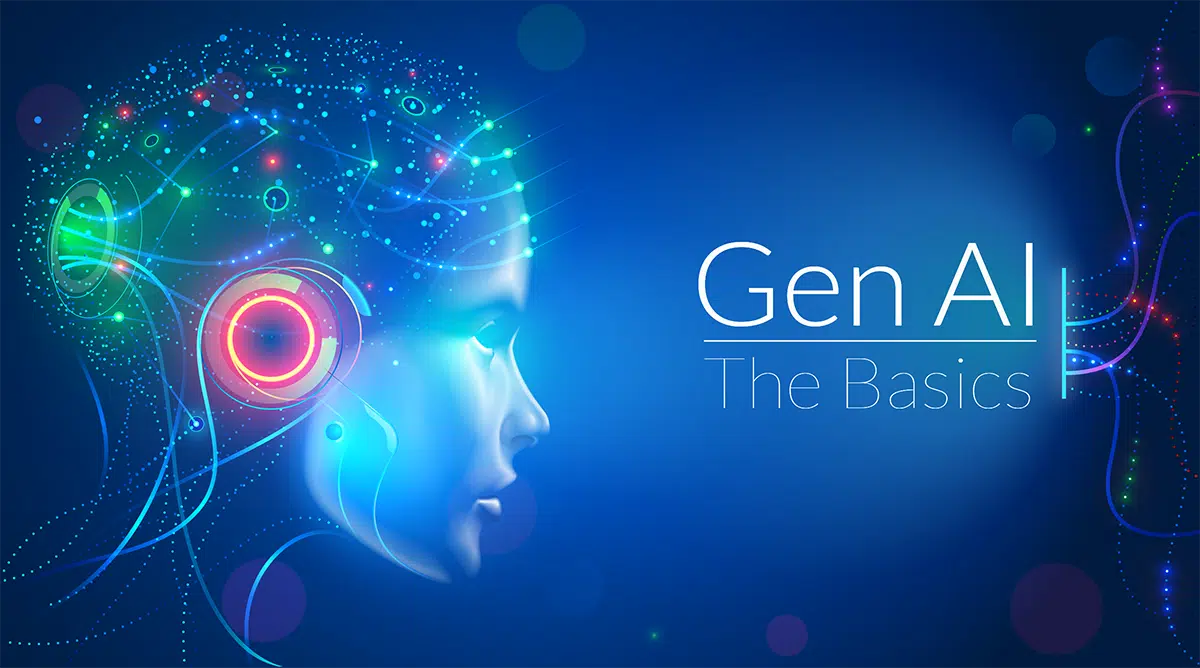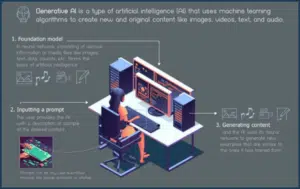Gen AI: The Basics
October 19, 2023

5 min. read
In the ever-evolving landscape of artificial intelligence, Generative (Gen) AI stands as a remarkable breakthrough, offering a world of possibilities. It’s all about creating something new, something unprecedented – a realm of limitless creativity. Imagine it as an artist’s canvas, where AI paints with text, images, and more.
To understand Generative AI, let’s dive into its fundamental components:
Foundation Model (The Brain)
The foundation model, often referred to as “The Brain,” is the cornerstone of Generative AI. It’s a pre-trained model infused with an abundance of data and knowledge. This foundational knowledge empowers Generative AI to create, generate, and innovate. The beauty of it lies in its adaptability – it can be fine-tuned or specialized for specific tasks, giving it flexibility like no other. Its versatility is unparalleled, allowing it to handle a myriad of tasks, in contrast to traditional models designed for a single specific job. For instance, ChatGPT, backed by different versions of foundation models, can facilitate a wide range of interactions. These models are trained on data at an “internet scale,” surpassing what a typical organization could amass.
Applications vs. Models
Think of foundation models as the brains and applications as the user-friendly interfaces. When you interact with applications like ChatGPT, you’re essentially engaging with the underlying foundation model developed by OpenAI. This concept extends across various domains, including text, code, images, and speech, each having its own unique foundation models.
The Prompt (Guiding Instruction)
The prompt serves as your guiding light in the world of Generative AI. It’s the instruction, the nudge, that you provide to the model. This directive prompts the AI to conjure something unique and extraordinary based on your input.
- A “prompt” is a simple instruction or query provided to a Generative AI model to guide its response.
- It’s a brief, user-provided input that initiates the AI’s creative or informative output.
- Prompts are usually concise and designed to elicit a specific kind of response from the AI.
- They are akin to asking a question or giving a directive to the AI.
Prompt Engineering
Prompt Engineering is the art of crafting the right input to guide AI models in generating desired outputs. It signifies a shift in programming – instead of intricate coding, you can now simply communicate with AI in plain English or any language of your choice. This evolution underscores the growing role of natural language in future automation, simplifying the way we instruct AI and prompting it to create code and content effortlessly.
- “Prompt engineering” is a more involved process where users create or fine-tune prompts to achieve desired AI responses.
- It involves crafting prompts in a way that maximizes the likelihood of getting the desired output.
- Prompt engineering can be a complex art, as it may require experimenting with different prompts, formats, and techniques to fine-tune AI model behavior.
- It aims to optimize the quality, relevance, and accuracy of AI-generated content.
A “prompt” is the initial input you provide to the AI, while “prompt engineering” is the deliberate and strategic effort to refine or design prompts effectively for specific outcomes, making the AI interaction more precise and valuable.
The Creation (Tangible Value)
The magic happens in the creation. This is the end result, the tangible value derived from the process. The AI uses its vast “knowledge” to craft something fresh and innovative, all based on your initial hint.
How Generative AI Differs from Traditional AI
Greg Hodgkinson, CTO and Head of Engineering at Prolifics, brilliantly explains the evolution of AI in his blog, With Generative AI, AI Becomes Bigger And Better | Prolifics. Traditional AI often demanded extensive data for training a model to perform a single task. This process was resource-intensive and costly, resulting in a limited return on investment.
Generative AI flips the script by leveraging foundation models. It offers versatility and adaptability with significantly less upfront effort. This paradigm shift makes AI implementation for business applications more accessible and cost-effective.
The Impact on Businesses
Generative AI introduces a transformative approach to AI for business applications. It not only promises a significantly better return on investment but also ushers in a new era of specialized foundation models. These models are tailored for specific industries, expanding their capabilities beyond the generic functionalities of models like GPT. Moreover, many businesses are now exploring autonomy in AI implementation, integrating this technology into their cloud-based or on-premises platforms. This integration can be seamlessly achieved through specialized platforms designed for foundation model interactions and prompt engineering.
As Generative AI continues to expand its horizons, numerous organizations are diving into this space, captivated by its limitless capabilities and potential for transformative innovation. The future is boundless, and the canvas of Generative AI is waiting for your creative strokes.
Connect with a Prolfiics Gen AI Expert –> Click Here
Learn more about Gen AI –> Click Here

